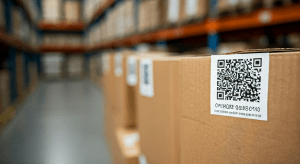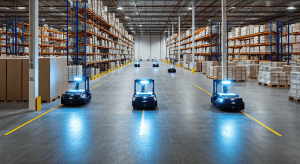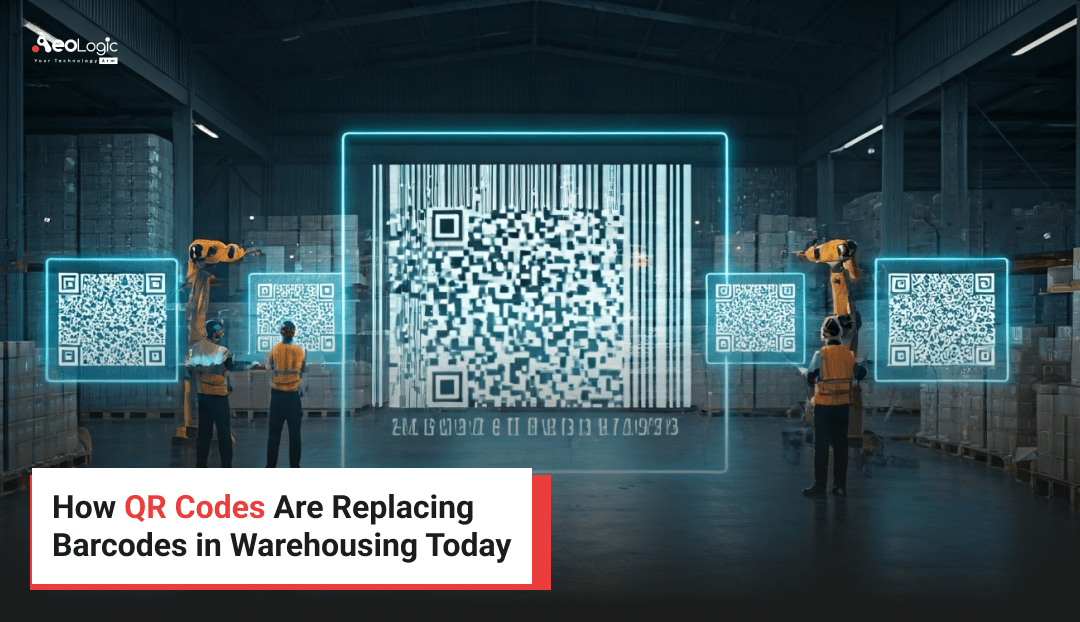Warehouses today are seeing many changes as new technology comes in. QR code technology is now a key part of how warehouse operations get better. Older traditional barcodes are starting to be replaced with QR codes. These QR codes can hold a lot of information.
QR codes help to make warehouse operations better. They let you scan things fast and check your inventory in real time. You can also store more data with these codes. When businesses use QR codes in inventory management, they get more accurate at keeping up with their stock. This makes it easier for people to work together and get the job done in the warehouse.
Switching to qr code technology in a warehouse is a big change. This helps people at work get better at inventory tracking and managing items. It will also make their work and all the processes in the warehouse easier and faster with the use of qr code.
The Evolution of Warehouse Labeling Technologies
Warehouse systems have been using tagging tools to help everything run well. For many years, people have used barcodes for a lot of jobs. They use them for inventory tracking or to find products. But, a barcode can only hold a small amount of data. It also has limited uses. This often makes the work slower and makes people look for better ways to do things, like qr code.
Now, there are new and smart ways like using QR code systems that change the way people do inventory management. These tools help things move faster in the warehouse. You can also keep all the detailed product information in one place. They help us meet the supply chain demands of today. If you use these innovative technologies, you will also see the level of work in the warehouse get better. Your team can get more done in less time, and all the product information will be ready when you need it.
People can use QR code systems to track and save more product information. This is helpful for inventory management and supply chain work. When warehouse systems use QR code tools, they often do better. They can handle more product data and stay linked with other systems in the supply chain.
Brief History of Barcode Adoption in Warehousing
Barcodes changed how things worked in warehouses in the late 1900s. Before, you did not see them in many places. The first barcodes were just a line across with numbers. These numbers saved product information. With barcodes, people could do their work much faster and with less trouble. Soon, UPC barcodes were used everywhere. Now, with UPC barcodes, all packaging could have the same way to find out what each product was.
Barcode scanners made things easier for workers. They did not have to type in all the information by hand. Warehouses started to use this to keep the supply chain better. They could track their products in a simple way and know where things were at any time. This extra accuracy helped make inventory management better. It also made products leave the warehouse faster.
There were still some problems with the use of traditional barcodes. These barcodes did not keep much data in them. It was also tricky to read them if the label had even some small amount of damage. Over time, warehouses had more things they needed to handle. People saw that they needed to move to a better way. That is when QR codes could help and do things that traditional barcodes could not.
Introduction and Growth of QR Codes
QR codes were first created in 1994 by Masahiro Hara and his team at Denso Wave. They wanted to solve some problems with barcodes. The team wanted people and factories to get a quick response when they scanned something. This new way made it easy for them to track parts while working in a factory.
When smartphones started to have qr code scanners, more people began to use qr codes. A lot of shops started to use them, and this changed the way things moved from one place to another. Now, qr codes are helpful in many places, not just a couple. People use qr code generators for inventory management and also for marketing.
During the COVID-19 pandemic, many people started using QR codes even more. Businesses used them a lot for contactless service. This made people feel safer and trust QR codes more than before. Now, in warehouse operations and places where people keep track of supplies, many see how QR codes can help. QR codes make inventory management better by helping to track things and keep lots of data at the same time.
How Barcodes Work in Warehousing
Traditional barcodes use black lines with number codes for products. Scanners read these lines quickly. In warehouses, traditional barcodes help a lot with inventory tracking. They let workers put in stock details in less time. This way, people can work faster and make fewer mistakes with the inventory tracking.
But, because traditional barcodes show data in only one direction, they do not meet all the needs of today’s supply chains. They can hold only a small amount of product information and need labels that have no damage. Because of this, traditional barcodes often do not give the best results. Now, businesses want better options. Many now use QR codes. These are more reliable for scanning and can keep a lot more product information for inventory tracking.
Barcode Structure and Data Capacity
Barcodes have simple lines that stand for numbers. These numbers hold product information. A barcode is tied to a global trade item number. This helps warehouse teams by letting them check real items against online records. It makes tracking products fast and easy.
But there are limits to what barcodes can do. A barcode can only have about 20 characters of data in it. So, teams often need extra tools to get more information on the products in the warehouse. This makes work take more time and can slow things down. Sometimes, the scanner does not read barcodes right. This can happen if the labels are old or damaged. This often leads to even more delays at work.
QR codes are not the same as the old-style barcodes. They use shapes that go both up-and-down and left-to-right. A QR code can hold a lot more data. This includes things like binary data. QR codes are good for warehouse operations. They help when you need to look at deeper or more detailed information at every point in your inventory.
Common Barcode Applications and Limitations
Barcodes are still used a lot in warehouses. They are there for tagging product details, batch numbers, and inventory status. Barcodes make it easy for people to get the data they need fast. These barcodes also help to track shipments when they come in or go out.
But, traditional barcodes do have some problems:
- The data capacity of barcodes is low. This means you can’t store much detailed product information like serial numbers or expiry dates.
- Manual data entry is often needed together with barcode scanning. This can make people get things wrong.
- When you scan, you have to line it up the right way. This takes more time and needs more work from people.
- Labels can be damaged, so they are not as dependable.
Traditional barcodes have some problems, so they may not work well for inventory management today. This means QR codes can step in and take their place.

The Rise of QR Codes in Modern Warehouses
QR codes are now used a lot on the warehouse floor. You can use them to check stock levels fast and know where things go. Their design let scanners read the codes from many angles. This helps stop errors and works better than barcodes.
When you use QR code scanners with inventory management systems, you get detailed product information right away. This can help to speed up the whole process from when the goods come in to when they go out. You do not have to type things in by hand as much, which saves time and cuts down on mistakes. This is why more people now use QR code scanners and see them as a good choice for inventory management and keeping up with product information. With this change, getting up-to-date and detailed product information has become much easier for all of us.
Technology Behind QR Codes
QR codes use black squares set on a white grid. These black squares hold binary data. Because of this, every QR code keeps special information inside it. There are finder patterns in three corners of the code. These patterns help scanners read QR codes from any direction. So, it is easy and fast to get the data out of them.
When you scan a QR code, the scanner gets the code’s data. A software reads this binary data and changes it into something you can use. This can be product details or a web link. A QR code is good for inventory management because it can store a lot of information in a small space.
You can make a QR code with a QR code generator. These tools let you add your product details or any other info you want. A QR code is very useful in inventory management. You can put many types of information in each code.
Key Advantages of QR Codes for Inventory
QR codes are good to use when you want better inventory tracking.
- Their large storage capacity lets you store a lot of detailed product information in the code, so you do not always need to use outside databases.
- Real-time updates help you keep the stock levels and locations right all the time.
- They can still be scanned because they have error correction, even if the code is a bit damaged.
- They are flexible, so you can use them to track shipments and handle returns with ease.
With all this, QR codes make it easier for warehouses to get inventory management right. You can lower labor costs, boost how well daily work goes, and keep up with what the supply chain needs right now. Because QR codes are simple to use, they stay important when it comes to product information and for making things better in this area.
QR Codes vs. Barcodes: A Detailed Comparison
When you look at barcodes and QR codes, you can see the advantages of QR codes. A barcode is good for simple identification. A QR code does more than that. It can hold a lot more data. This is useful for warehouse identification because it gives deeper information.
These extra features help with order fulfillment. They also make it easier to track things in the supply chain. As the supply chain and warehouses get more complex, QR codes give you the flexibility you need for modern work. They can manage a lot of information in real time and still be right.
Data Storage and Accessibility Differences
QR codes can keep more data than barcodes. They can hold things such as alphanumeric characters, binary data, and website URLs. This makes it easy for businesses to track their inventory. People get fast scanning every time with QR codes.
Barcodes can’t keep as much information as QR codes. They usually show only numbers or some letters and numbers mixed together. So, they are best for things that do not need to show a lot of details. A barcode must be lined up the right way to scan it. QR codes do not have this problem. That is why many people think QR codes are better for most jobs.
| Feature | Barcode | QR Code |
| Data Capacity | ~20 characters | 7,089 numeric/4,296 alphanumeric |
| Scanning Device | Dedicated scanner | Smartphones or tablets |
| Error Handling | Susceptible to damage | Built-in correction for partial damage |
Speed, Accuracy, and Error Reduction
QR codes can make things quicker, more correct, and not as easy to mess up compared to traditional barcodes. You can use a quick response to scan a qr code from any angle. This helps warehouse operations go much more smoothly.
When you put a qr code next to traditional barcodes, you will see it keeps mistakes down. A qr code has strong ways to fix small errors. If the qr code gets scratched or damaged, people can still scan it. This means qr codes do a good job, even when things get rough in a warehouse.
If you want things to move fast in order fulfillment, QR codes work better than barcodes. They help you keep track of inventory management, and you do not need to line them up. This makes QR codes a good choice for warehouses that want the best results and to work well every day.

Automation and Efficiency with QR Codes
Automation with QR codes helps make inventory management simple. When you use QR codes, you can scan items fast. You do not have to do as much work by hand. When you scan, you get instant stock details.
QR codes work well with a lot of digital platforms. This helps the whole system to be better. With this kind of automation, inventory management systems work smoother. They make it easy for people to track items right away. You can also get products checked in a lot faster. QR codes help warehouses do work with fewer mistakes. They also help people work at a faster pace, no matter what job is done in the inventory management process.
Real-Time Inventory Tracking Capabilities
QR codes make inventory tracking easier. They can store stock levels and serial numbers for each item. When warehouses scan these codes, they get quick updates on what they have in their system. This way, you can see all the important data about inventory with just one scan.
This means there will be less human error. Every step, like getting new inventory and shipping products, also gets done much faster. QR codes help stick to the plan, even when things get busy. Because of this, workers always get the right information, so they can make good choices without waiting.
For businesses, it is important to have more control and better visibility with QR codes. This helps the supply chain work well. It also makes sure that customer expectations are met.
Integration with Warehouse Management Systems (WMS)
Easy warehouse management can change the way you do inventory tracking and order fulfillment. Using QR code technology, you get real-time updates with detailed product information. You can check things like batch numbers and serial numbers on the spot. This helps businesses of all sizes see their stock levels right away. It also helps you cut down on manual data entry because the info is always there for you.
The advantages of QR codes go beyond saving time. They help increase customer satisfaction and make warehouse operations better for everyone. QR code technology also gives support as the supply chain changes. It helps businesses work faster and smarter by giving better product information.
Implementation Challenges and Solutions
Moving to use QR codes can feel hard when you start. A lot of warehouses do not have this thing yet. People might face many issues at first. Some of these problems are getting ready, changes at work, and knowing what to do next. The supply chain might need some new qr code scanners. The team will need to print strong labels. They also have to make sure older computer systems work better.
To keep up with supply chain demands, you need to have a good plan. Having the right training for your team also helps a lot. When you plan well and get help when you need it, you can use QR codes in your work, one step at a time. Soon, these QR codes can take the place of old barcodes. With QR codes, you can track what you have in your warehouse right now. This makes the job easier and faster for everyone. This way, the work in your supply chain will get done better.
Initial Setup and Equipment Considerations
Setting up a qr code system involves a few steps. First, you have to make your qr codes with a trusted qr code generator. This helps make sure that the right data goes in each qr code. You should make the qr code to match what you want for your inventory.
You need to have good, strong labels. This makes the qr code stay good for a longer time and not get messed up. You should get qr code scanners, or you can use a smartphone that has the right software for inventory. The equipment should work well with the qr code. Always put your labels in the same spot each time. This way, people can find and scan them fast and easy.
When you do all these steps, your qr code system will be more reliable. A good setup helps your business run better and lets it grow steady over time. If you take care of these things early, it will be easier to get better results from your qr code system later on.
Training Staff and Change Management
When you use QR codes at work, you need to make sure that all staff get good training. They must learn the new steps and the tools that come with this system. You should show them how QR codes make jobs easier for everyone. This can help people feel more involved when the new system starts.
Using QR codes at work helps save time because there are fewer manual tasks. This can help lower labor costs in the warehouse. It can also make the way work is done better. When orders get filled faster and it is easier to track items, customer satisfaction goes up.
Ongoing training and regular feedback meetings help teams use the QR code system better. This makes work go smooth. Over the long run, everyone gets to see better results with the qr code in place.
Future Trends in Warehouse Identification
New trends in the logistics world show that AI, IoT, and qr code systems are changing the way warehouses find and track items. These new technologies work together to help with things like making smart guesses with data, better use of automation, and easier tracking of every item. This lets people know where things are at all times and helps get those items to the right place faster.
As more warehouses start to use digital tools, qr code use will only get bigger. People will come up with new ideas for how to use them. These changes will help make things work better in warehouses. It will be easier to keep up with what the job needs and any new challenges that come up in logistics management.
AI, IoT, and Dynamic QR Code Innovations
Dynamic QR code changes are now working well with new AI and IoT tools. This makes inventory control much smarter in the way people use it. IoT sensors can be joined with a qr code. This helps people see and watch perishable goods as they move. You get updates in real-time. This way, you always know what is happening with your goods right now.
Smart AI looks at unique qr code data to learn from it and guess what could happen next. This helps a warehouse keep from running out of stock or facing problems with moving goods on time. With this, people who work in warehouses can make choices fast, using what is happening right now. The use of a qr code makes it easier to keep track of everything and be ready for any problems.
At the end of the day, qr codes and connectivity tools like IoT are helping shape the future of digital inventory systems. These teams use smart tools and track the logistics to make things work better for everyone.
Conclusion
QR codes have really changed how people work with warehouses. They help make things run better and faster than traditional barcodes. A QR code can hold more information. It can help you track things in real-time and works well with new warehouse management systems. All of this makes QR codes a good choice for any business, as they help things go more smoothly.
It is true that there can be some problems when you use this technology. But the good things are much bigger than these early issues. When you use QR codes in your warehouse, you put your business ahead. It helps you get better accuracy and faster work. If you want to move forward or improve how you handle inventory management, you can plan a talk with our experts. We can go over how QR codes will help your operations.
Frequently Asked Questions
Are QR codes more secure than barcodes for warehouse use?
Yes, qr code technology is safer than barcodes. The way you use qr code lets you keep data safe, even if there is more protection with encrypted data. If a qr code gets damaged or is hard to read, it can still scan well because of error correction. This means you will get a good scan most of the time. Using qr code in your supply chain helps stop data leaks. It also makes warehouse operations go smoothly, as you can trust your scans to work.
Can QR codes fully replace barcodes in all warehousing operations?
QR codes work better than many other tools, but there are some old warehouse systems that still use barcodes for easy jobs. It can take time for companies to move everything over to QR codes. They need to spend money on new scanners and update their inventory management and warehouse systems. This helps make sure all parts work well together in inventory management.
What are the cost implications of switching to QR codes?
Switching to QR codes means you have to pay at the start for the initial setup. You will need to buy strong labels and scanners that work well. Also, you will have to give your staff some training. But over time, you will save on labor costs. Your team will make fewer mistakes, and the whole process will be smoother. These things will be worth more than what you spend at first. So, this is a good choice for your business in the long run.
How do QR codes improve automation in inventory management?
QR codes help make inventory management simple and fast. They let you link inventory tracking in real-time to systems that read qr code data as soon as it comes in. This cuts down on the manual work you have to do. It is also good to use qr codes because they help you speed up the way you work and get more done in less time. Because of these things, qr codes are now an important part of how people handle inventory management today.
What should warehouses consider before transitioning to QR codes?
Warehouses have to look at equipment upgrades, staff training, and if the QR code scanner will fit with their system. They also need to find ways to make their work steps easier. Doing these things helps them be ready for any changes in warehouse operations. This makes it easier to use better ways, like working with a qr code in warehouse operations. Getting ready well will help them get the most from these new systems.







